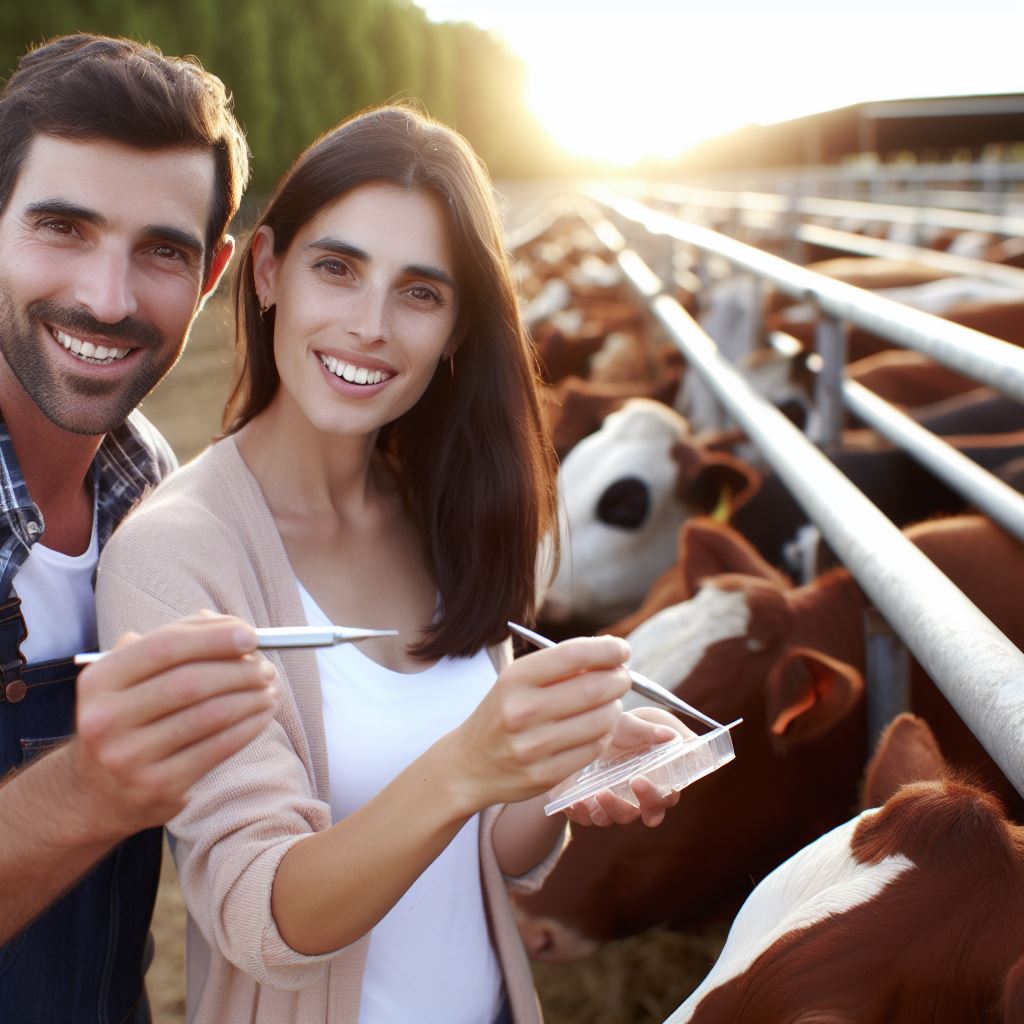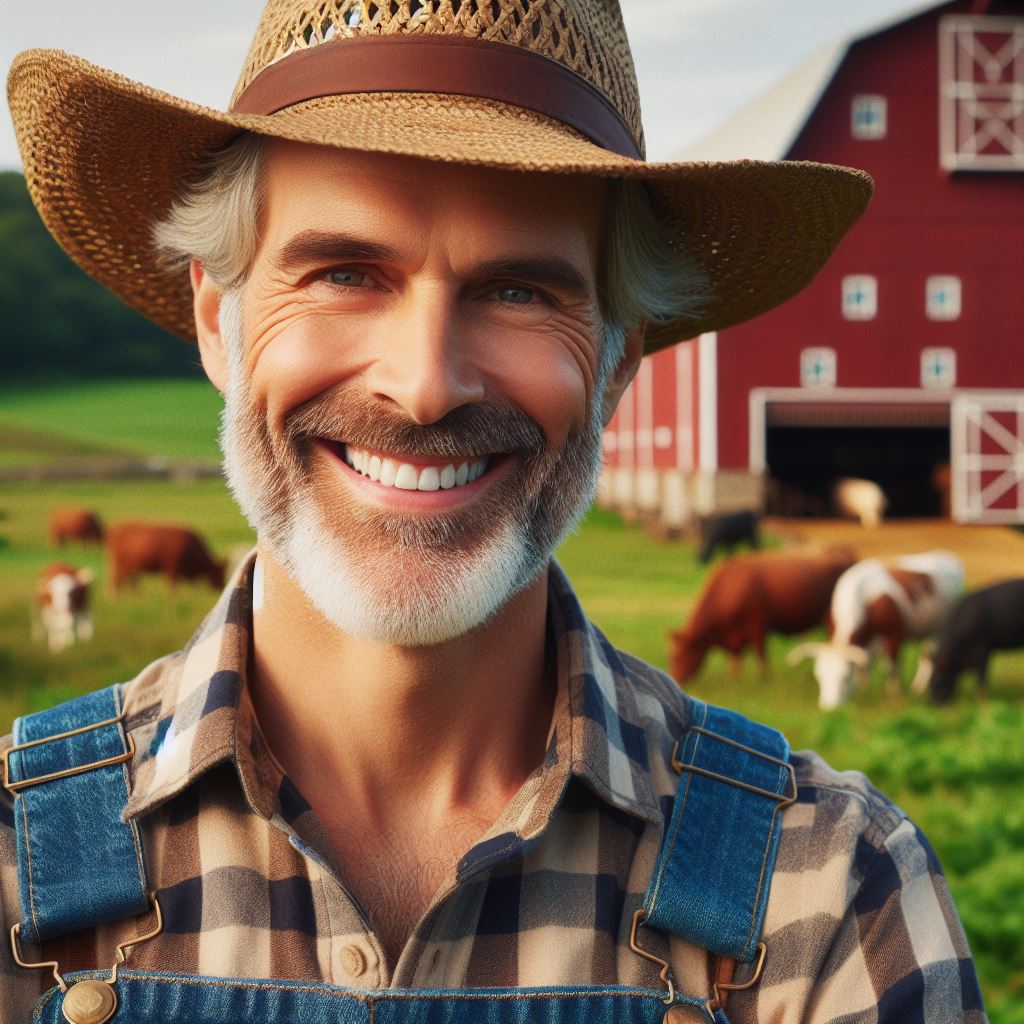Introduction
Optimizing feed for livestock is crucial for maintaining the health and productivity of animals.
By providing a balanced and nutritious diet, farmers can ensure that their livestock thrives and produces high-quality products, such as milk, meat, and eggs.
Expert advice on optimizing feed revolves around a few key principles.
First, it is essential to understand the specific nutritional needs of different livestock species and individual animals.
This knowledge allows farmers to create custom feed plans that provide the right balance of protein, carbohydrates, fiber, vitamins, and minerals.
Additionally, experts emphasize the importance of sourcing high-quality ingredients for livestock feed.
This involves carefully selecting grains, forages, and supplements that meet the nutritional requirements and are free from contaminants or toxins.
Another crucial aspect is feed management.
Experts recommend feeding animals according to their energy requirements and dividing the daily ration into multiple smaller meals to prevent digestive issues and maximize nutrient absorption.
Moreover, optimizing feed for livestock also involves regular monitoring and adjustment.
By regularly assessing the body condition, weight, and overall health of animals, farmers can make necessary modifications to their feed plans, ensuring that they meet the changing needs of livestock.
In essence, optimizing feed for livestock is of utmost importance for farmers.
By following expert advice on understanding nutritional needs, sourcing quality ingredients, and implementing proper feed management, farmers can enhance the health and productivity of their livestock, leading to improved farm profitability and sustainability.
Understanding Livestock Nutritional Needs
Different types of livestock and their dietary requirements
- Cows: require a diet high in fiber, such as grass and hay, to support their rumen fermentation process.
- Pigs: need a balanced diet combining grains, protein sources, and essential vitamins and minerals.
- Chickens: require a diet rich in protein, grains, and calcium to support egg production and overall health.
Importance of providing balanced nutrition for optimal growth and health
- Proper nutrition ensures livestock grow at a healthy rate, avoiding developmental issues.
- A balanced diet also helps prevent diseases and improves the immune system of livestock.
- Optimal nutrition leads to better reproductive performance and milk production in dairy animals.
Basics of livestock digestive systems and nutrient absorption
- Livestock have complex digestive systems that differ slightly across species.
- Cows, for example, have a four-compartment stomach system to efficiently digest fibrous materials.
- Nutrients are absorbed in the small intestine, where enzymatic breakdown and absorption occur.
- Microorganisms in the rumen of some livestock, like cows, help break down and ferment complex carbohydrates.
Understanding livestock nutritional needs is vital for optimal growth and health in cows, pigs, and chickens:
- Cows (Ruminants): Rely on high-fiber feed for proper rumen fermentation, extracting nutrients efficiently.
- Pigs: Require a balanced diet with grains, protein, vitamins, and minerals for growth and disease prevention.
- Chickens: Need protein for egg production and muscle development, along with grains and calcium-rich feed.
Balanced nutrition is crucial for livestock growth, health, and disease prevention:
Transform Your Agribusiness
Unlock your farm's potential with expert advice tailored to your needs. Get actionable steps that drive real results.
Get Started- Growth and Development: Prevents stunted growth and ensures overall well-being.
- Disease Prevention: Strengthens the immune system, reducing susceptibility to infections.
Optimal nutrition is essential for dairy animals like cows:
- Reproductive Performance: Enhances fertility and reproductive success.
- Milk Production: Ensures high-quality milk production.
Understanding the complex digestive systems of livestock is key:
- Diet Formulation: Tailoring diets based on species-specific digestive systems.
- Nutrient Absorption: Ensures the right proportions of nutrients for efficient absorption.
In some animals, like cows, the rumen is crucial for digestion:
- Rumen Function: Microbial fermentation allows efficient breakdown of complex carbohydrates.
- Energy Source: Enables the utilization of cellulose in plant cell walls as an energy source.
Basically, meeting the nutritional needs of livestock species is crucial for their well-being and optimal functioning.
A well-balanced diet ensures efficient nutrient absorption, promoting growth, health, and productivity in diverse farming operations.
Read: Water Management in Livestock Farming
Selecting the Right Feed Ingredients
Evaluating the nutritional composition of feed ingredients
When optimizing livestock feed, it is crucial to carefully assess the nutritional composition of the feed ingredients.
Each ingredient should provide the necessary nutrients to support the health and growth of the animals.
Analyzing the protein, carbohydrate, and fat content is key to ensuring a balanced diet for livestock.
Identifying suitable sources of protein, carbohydrates, and fats
Finding appropriate sources of protein, carbohydrates, and fats is vital for optimizing livestock feed.
Protein can be derived from various sources such as soybeans, alfalfa, or fish meal,
while carbohydrates can come from grains like corn or wheat.
Fats can be sourced from oils like soybean or canola oil.
Choosing high-quality and easily digestible ingredients will promote optimal nutrition and animal performance.
Considering specific needs of each livestock species
Tailoring the feed ingredients to meet the specific needs of each livestock species is essential for their well-being.
Different animals have varying dietary requirements and preferences. For example, cattle may require higher levels of energy and fiber compared to poultry.
Understanding these distinctions and providing the appropriate nutrients will ensure optimal health and productivity.
When it comes to optimizing feed for livestock, selecting the right feed ingredients is of paramount importance.
By evaluating the nutritional composition of the ingredients, identifying suitable sources of protein, carbohydrates, and fats, and considering the specific needs of each livestock species, farmers can provide a well-balanced diet that promotes the overall health and performance of their animals.
Through careful assessment and analysis, farmers can ensure their livestock receive the necessary nutrients to thrive and produce high-quality products.
The right combination of feed ingredients can enhance growth, reproduction, and overall animal health.
It is crucial for farmers to stay informed about the nutritional requirements of different livestock species and continuously monitor their animals’ diet to make any necessary adjustments.
Consulting with a nutritionist or veterinarian is highly recommended to achieve optimal results.
In the next section, we will discuss the importance of proper feed processing techniques to further enhance the nutritive value and digestibility of livestock feed.
Stay tuned for valuable insights on how to optimize the feed processing stage for maximum benefit to your animals’ health and performance.
Showcase Your Farming Business
Publish your professional farming services profile on our blog for a one-time fee of $200 and reach a dedicated audience of farmers and agribusiness owners.
Publish Your ProfileRead: Livestock Record Keeping: Tips for Efficiency
Balancing Nutrient Content
Formulating feed rations according to livestock stage (e.g., growth, lactation)
When optimizing feed for livestock, it is crucial to consider the specific stage of the animal.
Different stages require different nutrients for optimal growth and productivity.
By formulating feed rations according to the livestock stage, farmers can ensure that the animals receive the necessary nutrients for their development.
Determining appropriate levels of protein, energy, vitamins, and minerals
Protein, energy, vitamins, and minerals play a vital role in the overall health and well-being of livestock.
Expert advice suggests determining the appropriate levels of these nutrients based on the specific needs of the animals.
Protein is essential for muscle development and repair, energy is necessary for growth and reproduction, while vitamins and minerals support various bodily functions.
Avoiding nutrient deficiencies or excesses through proper calculations
To optimize feed for livestock, it is crucial to avoid both nutrient deficiencies and excesses.
Through proper calculations and careful monitoring, farmers can ensure that the feed rations provide the right balance of nutrients.
Nutrient deficiencies can lead to stunted growth, poor reproduction, and weakened immune systems, while nutrient excesses may result in health issues and inefficient feed utilization.
Proper calculations involve considering the nutrient requirements of the livestock, the nutrient content of available feeds, and any additional supplements required.
Regular assessments and adjustments are necessary to maintain an optimal nutrient balance in the livestock’s diet.
When optimizing feed for livestock, balancing nutrient content is crucial to ensure proper growth, health, and productivity.
By formulating feed rations based on the specific livestock stage and determining the appropriate levels of protein, energy, vitamins, and minerals, farmers can meet their animals’ nutritional requirements.
Avoiding nutrient deficiencies or excesses through proper calculations is essential to prevent health issues and maximize feed utilization.
Regular assessments and adjustments are necessary to maintain an optimal nutrient balance.
By following expert advice and optimizing feed for livestock, farmers can achieve optimal results and ensure the well-being of their animals.

Ensuring Feed Quality and Safety
Importance of using high-quality feed ingredients
Using high-quality feed ingredients is crucial for maximizing livestock health and productivity.
High-quality ingredients provide essential nutrients and minimize the risk of nutrient deficiencies.
Benefits of using high-quality feed ingredients:
- Improved animal growth and weight gain.
- Enhanced immune system function.
- Reduced risk of diseases and infections.
- Optimal reproductive performance.
When selecting feed ingredients, it is important to consider the source, processing methods, and nutritional composition.
Evaluating feed ingredients for potential contaminants or toxins
Regular evaluation of feed ingredients is necessary to ensure that they do not contain any harmful contaminants or toxins that could compromise animal health and safety.
Steps for evaluating feed ingredients:
- Conducting laboratory tests to detect pesticide residues, heavy metals, or mycotoxins.
- Checking for past records of ingredient quality and safety.
- Working closely with suppliers who follow strict quality control measures.
By thoroughly assessing feed ingredients, potential risks can be minimized, ensuring the well-being of livestock.
Protecting feed from spoilage and deterioration
Proper storage and handling practices are essential to prevent feed spoilage and deterioration, which can lead to nutrient loss and increased contamination risk.
Tips for protecting feed from spoilage and deterioration:
- Store feed in a clean and dry environment with controlled temperature and humidity.
- Use appropriate storage containers that are resistant to pests, rodents, and moisture.
- Implement a first-in, first-out (FIFO) system to ensure older feed is used first.
- Regularly inspect feed for signs of mold, moisture, or insect infestations.
- Avoid prolonged exposure of feed to sunlight.
By following these practices, feed quality can be maintained, ensuring optimal nutrition for livestock and minimizing the risk of feedborne illnesses.
Ensuring feed quality and safety is crucial for optimizing livestock performance and health.
By using high-quality feed ingredients, evaluating potential contaminants, and protecting feed from spoilage, livestock producers can provide their animals with the best possible nutrition and minimize the risk of diseases and infections.
Read: Eco-Friendly Livestock Farming Techniques
Enhancing Feed Palatability
Achieving optimal feed intake is crucial for the overall health and productivity of livestock.
By enhancing feed palatability, farmers can ensure their animals receive the necessary nutrients without any resistance or reluctance.
Incorporating additives and flavorings to improve feed acceptance
- Use natural additives like molasses or vegetable oil that can enhance the taste and aroma of the feed.
- Experiment with different flavors, such as apple or cinnamon, to entice animals into consuming their feed.
- Gradually introduce additives to avoid sudden changes that may lead to feed refusals.
- Monitor animal responses and adjust the quantity and type of additives accordingly.
- Consult with a nutritionist or veterinarian to ensure the safety and effectiveness of the chosen additives.
Understanding livestock preferences and adjusting feed accordingly
- Observe the eating habits and preferences of different livestock species on the farm.
- Consider the specific breed, age, and physiological requirements of the animals when formulating feed.
- Analyze feedback from the animals, such as feed refusals or selective eating, to identify preferences.
- Adjust the feed composition and ingredients to cater to the identified preferences and nutritional needs.
- Regularly monitor changes in feed intake and make necessary adjustments based on the animals’ response.
Addressing possible feed aversions or allergies
- Watch out for any signs of aversions, such as decreased feed intake or behavioral changes.
- Identify potential allergens or problematic ingredients by conducting feed trials or consulting experts.
- Remove or replace ingredients that are causing aversions or allergic reactions in the livestock.
- Gradually introduce new feed options to minimize the risk of adverse reactions.
- Regularly monitor the animals’ response to the modified feed and make further adjustments if necessary.
By enhancing feed palatability and addressing feed aversions or allergies, farmers can ensure good nutrition intake and overall well-being in their livestock.
Read: Managing Livestock Stress: Strategies & Tips
Monitoring Livestock Performance and Making Adjustments
Proper monitoring of livestock performance is essential for ensuring their health and maximizing productivity.
Regular assessments of factors like growth, body condition, and overall health are key to identifying any potential issues early on.
Regularly assessing livestock growth, body condition, and health
Monitoring livestock growth allows farmers to gauge the effectiveness of their feeding program.
By regularly weighing the animals, farmers can track weight gain and identify any anomalies.
If there is a stall in growth or weight loss, it may indicate a problem that needs to be addressed, such as inadequate nutrition or illness.
Body condition scoring is another important aspect of livestock assessment.
Showcase Your Farming Business
Publish your professional farming services profile on our blog for a one-time fee of $200 and reach a dedicated audience of farmers and agribusiness owners.
Publish Your ProfileBy visually evaluating the animals’ body fat levels, breeders can determine if their feeding regime is appropriate and make adjustments if necessary.
Animals that are under or over-conditioned may require different feeding strategies to optimize their body condition for health and reproduction.
In addition to growth and body condition, monitoring the general health of livestock is crucial.
This involves observing their behavior, assessing their coat quality, and regularly checking for any signs of illness or disease.
By being attentive to these indicators, farmers can identify any health issues early on and take appropriate action, such as contacting a veterinarian for a diagnosis and treatment.
Identifying signs of feed-related issues and making necessary corrections
Feeding problems can have a significant impact on livestock performance.
Therefore, it is important to remain vigilant and identify any signs of feed-related issues promptly.
Common signs of feed-related problems include reduced feed intake, weight loss, diminished milk production in lactating animals, and changes in behavior like excessive aggression or lethargy.
When these signs are noticed, farmers should investigate the root cause of the issue.
It could be due to factors such as poor feed quality, improper feeding techniques, or feed formulation deficiencies.
Once the issue is pinpointed, appropriate corrective measures can be taken, such as adjusting the feed formulation, improving storage conditions, or altering the feeding schedule.
Seeking professional guidance for fine-tuning feed formulations
Fine-tuning feed formulations requires expertise, and seeking professional guidance can be highly beneficial.
Livestock nutritionists can analyze the composition of the feed and assess its adequacy for the specific needs of the animals.
They consider factors like the animals’ age, weight, activity levels, and intended purpose to optimize the formulation.
Professional guidance also helps in troubleshooting feed-related problems.
Nutritionists can identify any nutrient deficiencies or excesses in the feed and advise on necessary adjustments.
They can also recommend additives or supplements that can enhance the overall nutritional profile of the feed and improve livestock performance.
In summary, regular monitoring of livestock performance is crucial for optimizing feed efficiency and ensuring animal welfare.
Assessing growth, body condition, and health, identifying signs of feed-related issues, and seeking professional guidance for feed formulations are all essential steps in achieving the best outcomes for livestock.
Read: Winter Care for Livestock: A Complete Guide
Conclusion
Importance of optimizing feed for livestock productivity and welfare
Optimizing feed for livestock is crucial for maximizing productivity and ensuring the welfare of animals.
By providing the right nutrients in the right proportions, farmers can enhance growth rates, reproduction, and overall health.
Recap of expert advice and key takeaways for successful feed optimization
Throughout this blog section, we have gathered expert advice on optimizing feed for livestock.
Key takeaways include formulating balanced rations, using quality ingredients, proper storage, and regular feed analysis.
By following these recommendations, farmers can ensure that the nutritional needs of their livestock are met, leading to better performance and profitability.
Encouragement for farmers to continuously improve feed management practices
As the livestock industry continues to evolve, it is essential for farmers to stay updated on the latest research and advancements in feed optimization.
By adopting innovative practices and technologies, farmers can continuously improve feed management and stay competitive in the market.
Continuous learning, collaboration with experts, and regular evaluation of feed practices are crucial for maximizing efficiency, sustainability, and overall success in the livestock industry.
In closing, optimizing feed for livestock is not just a matter of improving productivity and profits; it is a responsibility towards the well-being of the animals under our care.
By prioritizing feed optimization, farmers can ensure the health, happiness, and productivity of their livestock, while contributing to the overall sustainability and success of their farm.




